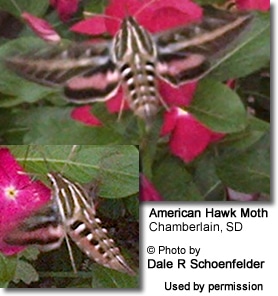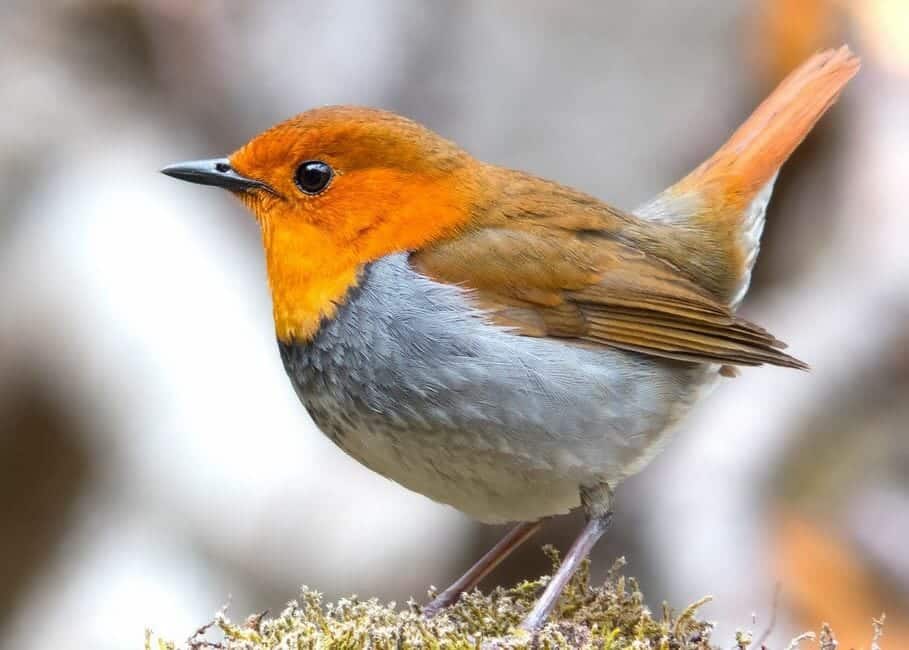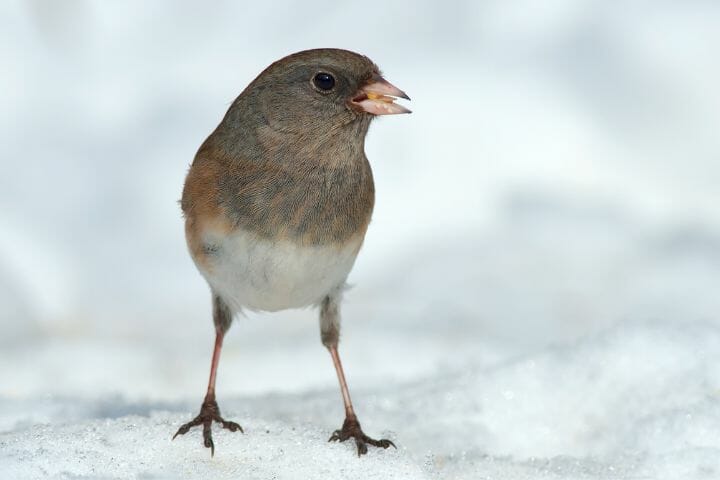Hummingbirds found in Utah, USA
Hummingbirds found in Utah, USA (by U.S. State) … Canada … Mexico … Puerto Rico … Jamaica … Honduras
Hummingbird Information … Hummingbird Species Photo Gallery
Most migratory hummingbirds arrive in Utah in late April or May and leave by mid-to-late September. They are most numerous in the southwest corner of the state. Some of them are breeding natives, while others are regular or occasional visitors. With a little bit of luck, rare vagrants can be found.
Hummingbirds found in Utah include the following:
The two most common and widespread hummingbirds in Utah are the Broad-tailed and the Black-chinned Hummingbirds …
Broad-tailed Hummingbirds (Selasphorus platycercus) – Breeding Natives … Most arrive early in May. These hummingbirds are usually found near bodies of water, in the lower valleys, and at higher elevations.
Males can most easily be identified by their iridescent, rose-red throats, white chest feathers metallic green back and crown, and rounded tails. The males’ tails make whistling noises in flight.
Females lack the flashy throat patch and have white-tipped tails that are green in the center bordered by feathers that are rust-colored close to the body and black in the center.

Black-chinned Hummingbirds (Archilochus alexandri) – Breeding Natives … One of the most common and widespread of all hummingbird species in Utah. They arrive in Utah around April for the breeding season and in September / October return to their wintering territories (as far south as Mexico). These hummingbirds generally remain at low and mid-elevations, where they nest close to bodies of water.
The male has a black, shimmering throat with a purple edge and pale feathers below that create a collar. However, unless the light is just right, the head looks all black. His back is green and there are some green feathers covering the chest.
The female is pale below (sometimes with a slightly speckled throat) and her back is green.

Rufous Hummingbirds (Selasphorus rufus) – Native hummingbirds. Both breeding and transient migrating populations occur in Utah. Breeding birds arrive in April and leave in September to return to their wintering territories. Migrating birds from as north as Alaska also travel through Utah as they travel to and from their wintering grounds. These long-distance migrants winter as far south as central Mexico.
These hummingbirds are usually found in gardens and feeders. These birds are fearless and are known for chasing away other hummingbirds and even larger birds, or rodents away from their favorite nectar feeders and flowers.
Males can easily be identified by their glossy orange-red throats.
Females have whitish, speckled throats, green backs and crowns, and rufous, white-tipped tail feathers.
Costa’s Hummingbirds (Calypte costae) – Native Breeders. Generally uncommon. Mostly found in Washington County located in the southwest corner of Utah bordering Arizona and Nevada, where they are usually nest in the Virgin River drainage. They usually arrive in Utah in March through June and leave in September to October.
Males can easily be identified by the glossy purple crown and long, conspicuous throat feathers that project markedly down the side of the throats, giving it an elongated “mustache” appearance. The back is metallic green.
Females have greyish-green crowns (top of the head) and backs. The chin and the plumage below are whitish, except for some black spotting on her throat. Her flanks are buffy-colored. She has a dark tail with white tips on the outer tail feathers.
They resemble Anna’s Hummingbirds, but the male’s gorget (throat feathers) is longer than that of Anna’s.
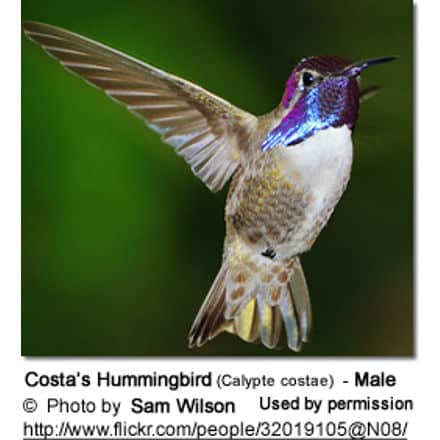
Anna’s Hummingbirds, Calypte anna – Rare winter visitors with only about one or two reported sightings a year. They are mostly found in the winter months, from March to December.
One of the largest and the most vocal hummingbirds in the United States, it is the only species to produce a song; specifically the males produce a complex series of scratchy noises, sounding like a sharp “chee-chee-chee; when moving from flower to flower, they emit toneless “chip” vocalizations. All other hummingbirds in the United States are mostly silent.
They are well known for their territorial behavior; the male makes elaborate dive displays at other birds and sometimes even at people. At the bottom of their dives, they produce high-pitched loud popping sounds with their tail feathers.
Males have glossy dark rose-red throats and crowns, which may appear black or dark purple in low light. The underside is mostly greyish; and the back metallic green.
Females have light grey chests with white and red spotting on the throat, greenish back, and white-tipped tails.
They resemble the Costa’s Hummingbirds, but the male Costa’s Hummingbird‘s gorget (throat feathers) is longer than that of the Anna’s. They are larger than the Rufous Hummingbirds and lack the rusty coloration of the Rufous Hummingbirds.

Calliope Hummingbirds (Stellula calliope) – Rare Visitors. Most likely to occur during the spring and summer months in the mountainous regions.
The smallest breeding bird in North America. They are most easily confused with the Rufous Hummingbirds and the Broad-tailed Hummingbird.
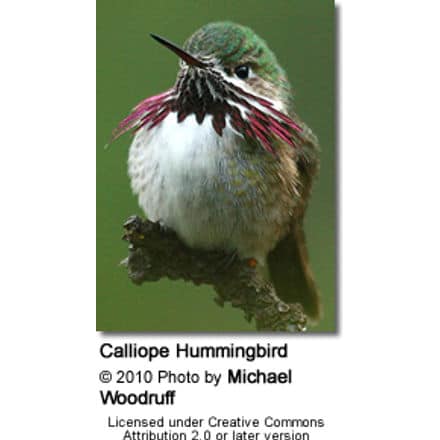
Broad-billed Hummingbirds (Cynanthus latirostris) – Accidental / Vagrants – These mostly Mexican hummingbirds venture into the United States regularly; they mostly visit the southern parts – but a few vagrants travel as far north as Wisconsin. Usually seen during the winter migration, between August and November. These Mexican
The male is glossy green above and on the chest. He has a deep blue throat. His straight and slender beak is red with a black tip. His slightly forked tail is dark above, and the undertail feathers are white.
The female is less colorful than the male. Her throat, chest, and belly are light to medium grey. She has a white stripe over each eye.

Magnificent or Refulgent Hummingbirds (Eugenes fulgens) – Rare, accidental visitors. Sightings were reported during the spring migration, from May to August.
These are large hummingbirds and can often be identified by their size alone.
The male has a metallic green throat and a black chest. His forehead and crown are purple and the back is dark green.
The female plumage is less bright. Her chest is solid grey. Her back and crown are olive green. Her tail feathers are pearl-grey tipped.
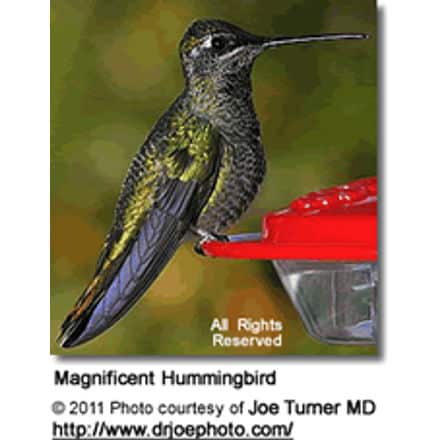
Rufous Hummingbird versus the similar Ruby-throated Hummingbird (Identification)
Is it a Hummingbird or an Insect?
The Hawk Moths (often referred to as “Hummingbird Moth”) is easily confused with hummingbirds, as they have similar feeding and swift flight patterns. These moths also hover in midair while they feed on nectar.
Moths have a couple of sensors or “antennas” on top of the head, which are key identifiers.

